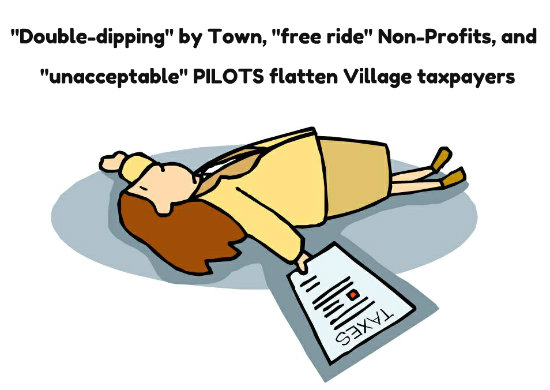
—Nina Pierpont, MD, PhD
Two financial issues are driving the question of village dissolution: high taxes in the village and the fear that the village may become bankrupt within a decade. There is a common perception that the village has mis-managed its budgets and departments by allowing contracts/salaries/benefits to become recklessly generous. Indeed, there is now a growing sentiment that we don’t really need these village employees who, not surprisingly, are starting to feel blamed for the village’s financial woes.
What’s going on, here, is a cascade of misinformation about village finances. As I hope to make clear, village dissolution is not the only way—in fact, it is the least attractive way—to restructure taxes and service funding within the Township of Malone.
Dissolution will cause us to lose a critical service—the Malone Village Police. The Town of Malone is unlikely to establish a town-wide police service (notice that town councilors refuse to commit themselves on this, while two councilors, including the supervisor, are vocally against it). Nor is there any guarantee the state will designate a special police district within the town if the village is dissolved (we have heard so from Janet Duprey). With dissolution, the police will go.
Let’s talk about how taxes and services are structured in Malone. They are pretty complicated, yet essential to understand.
First, how do tax bills compare in village and town for an average family? Let’s imagine a house and property valued at $80,000 in each place. In the Town of Malone, this family would pay $893.08 per year in town/county taxes. In the village, it would pay $605.40 in town/county taxes and $1326.05 in village taxes, for a total of $1931.44. That’s $1038.44 more in the village. (School taxes are the same in both locations.)
Why so much more in the village? What’s different about it?
In the village we have municipal water, municipal sewer, drains under the streets, lights over the streets, sidewalks, street cleaning, a police force, a recreation program with parks and an ice rink, leaf and brush pickup, tree maintenance, and unsafe building demolition.
Both the town and village maintain roads, plow snow off roads, have a clerk and treasurer, have governing boards of five people, issue building permits, perform code inspections, and do some planning. The town also builds new roads and maintains an airport. Taxes paid to the town fund a number of programs for both the town and village, which are administered by the town: the fire protection system, the combined judicial system, election services, tax assessment services, dog control (although the Animal Control Officer tells the village police she won’t cover the village), and contributions to the Malone Chamber of Commerce and programs for the aged.

Water and sewer
The extra village taxes ($1038.44, in the example above) do not fund the water and sewer, which pay for themselves out of water and sewer rents. These are collected from everyone who uses these systems, including private, government, and tax-free entities. The water system feeds the entire village and has a westward extension along Route 11 to the Meehan Road, as well as providing water to the prisons and a collection of households in Whippleville. The rents are modest and an excellent value compared to building and maintaining one’s own well and septic system, as one would in the country.
6.5% of the water system budget is paid by a special contract with the NYS Dept. of Corrections, which pays the village $101,000 yearly to cover about half of the debt service for the $4 million improvement (with new wells and water main) constructed about 15 years ago when the Upstate Correctional Facility was built.
Here’s where things begin to get strange. The village water system is itself taxed as if it were a collection of business properties, even though the properties belong directly to the Village of Malone, itself a tax-free government entity. The properties are the water treatment plant, the water main, the reservoir on the Pinnacle, and the water tower off Finney Blvd. All four properties are taxed by the Town of Malone/County and the Malone Central School District. The water tower is also taxed by the Village of Malone itself. These taxes, $164,000 worth, constitute 11% of the water system budget. About $7000 of that returns to the village as a village tax.
The village employees who run the water system, both administration and maintenance, do an excellent job. We have reasonable rates and the best municipal water of any place I’ve ever lived. Local lore has it that when the new wells were opened, the state inspector asked if we were going to bottle this stuff, it was so clean when unprocessed, right from the wells. It is given only a whiff of chlorine, easily cleared by a Brita filter. My husband and I drink bottled-quality water from our taps in the Village of Malone.
The village should consider getting into the highly lucrative water “bottling” business. Yes, I am dead serious. Small towns across America are finding that survival depends on exploiting their inherent resources. Our drinking water is definitely one of our commercial options.
The water and sewer system will continue whether or not village dissolution takes place. However, if dissolution takes place and its control changes hands, water rents could change. There is also that contract in place between the Dept. of Corrections and the Village of Malone that provides over $100,000 per year in water system debt service. If the village were dissolved, this contract—like those of village employees—would perhaps be voided. Would DOC, in this less prosperous era, try to negotiate a smaller payment?

DPW and the Highway Department
Village taxes fully fund the village Department of Public Works and related functions within the village General Fund. Though we see the same men around the village doing DPW work and water/sewer system work, the budgets for these operations are separate. DPW functions include lighting, cleaning, maintaining, and improving the streets, machinery, garage, removing brush and leaves, and removing snow from streets and sidewalks. The budget for village snow removal is $284,000 per year, of which $99,000 is salaries, $104,000 equipment and expenses, and approximately $81,000 benefits.
The Town of Malone Highway Department, on the other hand, is funded with two separate tax streams, one called the “Highway-Townwide” and the other the “Highway-Outside Village.” The Highway-Outside Village budget is slightly shy of $1 million and the separate Highway-Townwide budget is 53% of that, or $534,000. I asked the town budget officer, Mrs. Stewart, about these two funds. The Highway-Outside Village tax is levied only outside the village and covers road construction, maintenance, machinery, and personnel costs for roads outside the village. The Highway-Townwide tax is levied both inside and outside the village and covers the costs of snow removal. However, it only removes snow outside the village. Inside the village, our own village-funded DPW removes the snow. We villagers pay twice for snow removal. Townspeople only pay once.

Village and Town Offices
The budget of the village General Fund (which does not include the water and sewer systems) plus recreation totals $4 million, more than the entire budget of the town, which is $3.28 million. Yet the village has a lower budget for administration, with fewer personnel with lower salaries:
» The village mayor is paid $6000 per year and the town supervisor $13,750.
» Village trustees are paid $4000 per year and town $5500.
» The village treasurer is paid $28,312 per year for treasurer and budgeting functions, and the town person or people $40,230 for the two equivalent functions.
» The village clerk is paid $26,469 per year and the town clerk $29,657.
These numbers suggest that overall the town has higher administrative costs. Why, then, should we think that giving village functions to town personnel would result in greater efficiency or cost savings?
Editor’s note: Dr. Pierpont found she had to correct her figures in the above section, “Village and Town Offices,” for reasons she explains in a Letter to the Editor of the Malone Telegram. (Note that she published her article, identical to this one, in the Malone Telegram on November 2, 2012.
To the Editor,
On Friday, Nov. 2, I self-published an editorial in the Telegram, arguing against “dissolution.” In it I listed the salaries of the Malone Village officers—the Mayor, Trustees, Clerk, etc.—in every case in error.
Here’s why. I got my figures from the Village Budget, page 1A, General Fund Budget. Here the amounts for personnel for Board of Trustees, Mayor, Treasurer, Budget, and Village Clerk are listed.
What I did not know was that each of these people is paid in addition from the Water Fund and/or Sewer Fund. On page 1F we see personnel services for Water Administration rolled together into one number. On page 1G we see the same thing for Sewer Administration. We can’t tell who is paid what.
Furthermore, benefit costs are rolled together for each fund—one can’t tell how much the police are receiving vs. Village administrative or DPW employees, nor how much is going to support retirees.
Compensation and benefit values for the elected officials of both Village and Town are listed in the “Dissolution Study” prepared for the Village by the Center for Governmental Research in July 2012, on pages 24-25.
The Village Mayor makes $12,000 annually, compared to the Town Supervisor’s $13,750. Village Trustees are paid $8,000 annually, compared to $5500 for Town Councilors. It is not specified what appointed administrative personnel (such as Town and Village Clerk) are paid, either in the Village or Town Budgets or in the Dissolution Study.
Please understand that I am not suggesting the Village officers or Town officers are making unreasonably high salaries. The point I was drawing in my editorial was that Village officers consistently earn less per annum than comparable Town officers. In this I was wrong.
In the interest of promoting (a) shared services, (b) Village-Town tax equalization, and (c) support of the Malone Village Police Dept by all the entities in the Village who depend on it, we citizens need greater transparency with regard to costs in both the Village and Town. For example, documents could be posted on the Village and Town websites, in addition to the budgets, which spell out salaries and benefits for each employee and what is rolled into such terms as “contractual costs” within each sub-department or function.
Such detail and transparency are essential to a constructive dialogue on the costs of municipal government.
Nina Pierpont, MD, PhD

Malone Village Police
Our municipal police force is different from the state police. The Malone Village Police enforce village code (like noise, vulgarity, and disturbance laws) as well as responding to dangerous emergencies and threats and participating in crime investigations and arrests. They are nearby and respond quickly. Given the changing demographic of the village, they are critical for maintaining order and safety.
Who calls the police? Everyone in the village except the courthouse, it turns out, including private citizens and businesses, the hospital, the schools, and North Star and ARC houses where mentally disabled citizens live. The village police play a big role in the Franklin County Fair with its huge influx of people and traffic.
A sergeant estimated for me that the police answer 2-3 calls per week from the school system. “Kids run away from the high school and BOCES all the time,” he told me, and the police are called to find the errant youth and bring him or her back. Even the elementary schools call when they can’t manage a “tantrumming” 8-year-old. These calls come in the daytime when the police are most short of personnel.
The Alice Hyde Hospital calls the police once or twice a week, usually for a mentally ill and agitated or aggressive person who has been brought to the emergency room. The hospital has no security personnel of its own, instead relying on the free and reliable village police, even within its own doors. Sometimes the state police escort a mentally ill patient to the ER, who goes out of control after the trooper has left. The village police are then called.
Calls from the Franklin County Nursing Home or from ARC or North Star homes for the mentally disabled are sporadic but at times frequent and repetitive, for example if there is a string of thefts or a violent resident living in a home.
To understand the role of the village itself and the village police in our larger community now, in the 21st century, we must think of the services that are concentrated in the Village of Malone: the schools and college that serve Malone and a half-dozen surrounding towns, the hospital for the northern half of the county, and services for the mentally ill and disabled. The county government offices in the courthouse attract our least capable, stable, or self-sufficient citizens, who settle nearby. Subsidized housing has been built by the village, county, and tax-exempt entities like ComLinks. Businesses, on the other hand, mostly establish themselves outside village limits, such as the corridor to the west along Rte. 11.
This is a far cry from the demographics of the town and village that established these tax structures a century or more ago. Then, wealth, power, and business were concentrated in the village, and the extra taxes were most likely not a problem.

What does the police force cost? The “General Fund” of the village budget totals about $3.9 million, or a round $4 million if the village share of the recreation fund is included. It is covered by taxes, fees, and a small amount of state aid ($200,000, 5% of the total); all the rest of the village budget is covered by water and sewer rents. Within the General Fund, the police force budget is about $1.64 million (including an approximation of benefit costs for current and retired police officers). This is 42% of the tax-supported village budget.
The police contracts, as far as I understand them, are not the problem many people seem to think. The retirement plans of the Malone village policemen, as well as firemen and all town and village employees, are administered by the state. The town and village pay into the state retirement funds as employers, but after a policeman or other town or village employee retires, the town and village have no further responsibility. The state fund pays for their retirement and, like everyone else, they are also eligible for Social Security after age 62.
The medical insurance parts of the contracts constitute a direct, ongoing and expanding expense to the village and town for both active and retired members of the police and other village and town departments. This is not the fault of the police or past village or town governments as much as it is the fault of an out-of-control medical industry, whose expanding costs outstrip other forms of inflation. Our police, though, have recently renegotiated their health benefits to share more of the costs, changed unions to get cheaper health plans, and limited their own salaries for new hires for many years to come.
The village police are also understaffed. Out of a force of 12-13, three are out long-term for on-the-job injuries. Administrative progress towards medical retirement has moved slowly, hampering the force’s ability to replace these members with new hires who can work. In addition, as an additional austerity measure, the force recently lost both its detective (who handled all felony level cases) and its juvenile officer, who talked with all youths and parents whenever there was a juvenile complaint, whether or not an arrest was made. To make the force viable and effective, it needs to be returned to its complement of 12 officers plus the chief able to work, and in addition rehire the detective and juvenile officer and add one additional officer as a float for vacations, to save on overtime costs.

What should be done?
The Village of Malone is the non-profit service and welfare center of Northern Franklin County. Businesses don’t want to move to the village because taxes are higher and parking is generally a problem. Many people would like to move to the village to live because of the elegant old houses, the congeniality of neighborhood living, and the proximity to schools, churches, activities, and stores, especially given current high gas prices. However, village taxes can be a significant impediment. High taxes deter people from moving in, which restricts the tax base which in turn raises taxes—a positively reinforcing cycle that needs to be broken by specific measures to equalize village and town taxes.
1) Tax restructuring so that village residents do not pay double for services, once to the village and once to the same service “Townwide.” If state law dictates specific local government and tax structures, then we must figure out a means to pass money back to the appropriate village department to equalize costs. This most clearly applies to snow plowing. It also applies to recreation. The joint recreation program is shared by the village and town, with 60% coming from village taxpayers and the remaining 40% coming from village & town taxpayers. In other words, village taxpayers wind up paying twice for the same service. We need to examine other town and village expenditures to identify other funding duplications (double-dipping by the town).
2) Don’t tax the village water system. It is a non-profit, government-owned public utility. The savings of $157,000 (not counting the tax the village would not pay to itself) could perhaps be transferred to other village funds. This is nearly 10% of the police budget—a significant savings.
3) Funding the village police ($1.64 million per year, 42% of the general village fund). Non-profit, “wholly exempt” entities dominate the current landscape and demographic of the village and are its current major employers. Other than the county, which uses its own officers to secure the courthouse, these entities place major demands on the Malone Village Police and would indeed be unable to function without them. These entities are the Alice Hyde Hospital (excluding its doctors’ office buildings, which are not exempt); the Malone Central Schools; North Star/Citizens Advocates with its variety of offices, day treatment centers, and homes for the mentally ill and disabled; the Association for Retarded Children (ARC) with similar homes for disabled adults; and the Community Action Agency of Franklin County (ComLinks), Franklin County Community Housing Council, and Malone Village Housing Authority, who operate subsidized housing. There are other tax-exempt entities with a smaller presence and less potential police demand, such as the village’s many churches, the adult centers, the “Farrar Home for Deserving Ladies,” JCEO/Headstart, and the Franklin County Historical Society.
Other than the holdings of the Malone Village Housing Authority, the Franklin County IDA, and the Historical Society, these tax-exempt entities do not even pay for fire protection. (It is a mark of integrity that these three do.)
In a category by itself, with regard to “wholly exempt” entities, is the Franklin County Agricultural Society, which owns the Fairground and associated properties in the village (assessed at over $3 million), and operates a highly commercialized and heavily attended county fair for 10 days every year.
Though they may not have focused on this fact, all of these big, active, non-profit, tax-exempt organizations would suffer a significant loss in safety and viability if local police services were lost due to a vote for dissolution now or a future village bankruptcy. Thus these organizations have a vested interest in making sure that police services continue. They also have an interest in good roads and plowing (especially the schools with their daily operation of a fleet of school buses), and in vigorous, well-funded and well-equipped fire protection. The dwindling business and residential tax base of the village is fast losing its ability and willingness to solely support these services for the village non-profits.
There is a concept called the PILOT, or Payment in Lieu of Taxes. (The village already receives some PILOT payments to the tune of $49,000 this year, though, with one exception, I did not find out what these are for, or who pays them. That exception is Kmart. I am told by a Town Councilor that Kmart pays a PILOT instead of a tax—which, if true, sounds outrageous to me.) The Alice Hyde Hospital, the Franklin County Agricultural Society, the Malone Central Schools, Citizens Advocates, ARC, ComLinks, and the County and Village Housing Authorities need to negotiate PILOT payments with the Village of Malone to support, among them, a substantial amount of the village police budget (60%? 70%?), including expansion of the currently diminished police force back to a viable size. (If not a PILOT, then something equivalent.) Contributions to fire protection should also be added for those tax-exempt organizations that do not pay the town fire protection tax.
In summary, proposed measures are:
» ending taxation of the village water system
» returning funds from the Highway-Townwide fund of the town to the village for snow removal in the village
» ending duplication of recreational funding by village taxpayers
» examining town and village expenditures for other expenses villagers are doubly taxed for
» negotiating Payments in Lieu of Taxes (PILOT’s) for police, fire, and possibly road support from the large tax-exempt organizations that dominate the village landscape and economic life.
Dissolution, on the other hand, would mean loss of the local police force, which is not a tenable situation for businesses, residents, or the non-profit agencies operating in the village.
Links:
Malone Village budget http://www.malonevillage.com/PDF/2012-2013%20Budget.pdf
Malone Town budget http://www.malonetown.com/PDF/2012%20Budget.pdf
Malone Village tax roll http://franklincony.org/content/Departments/View/14:field=permits;/content/Permits/View/5:field=documents;/content/Documents/File/2536.pdf
Malone Town tax roll http://franklincony.org/content/Departments/View/14:field=permits;/content/Permits/View/2:field=documents;/content/Documents/File/2143.pdf
Malone Central Schools tax roll http://franklincony.org/content/Departments/View/14:field=permits;/content/Permits/View/6:field=documents;/content/Documents/File/2699.pdf
